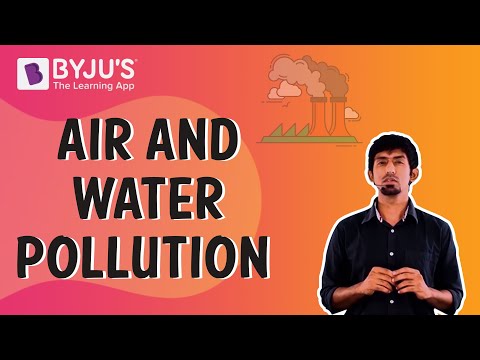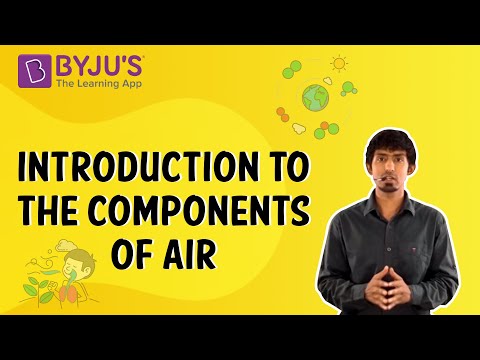Air pollution is the poisoning of air caused by the presence of compounds in the atmosphere that are hazardous to human and other living beings’ health, as well as to the environment and materials.
Gases (like ammonia, carbon monoxide, sulphur dioxide, nitrous oxides, methane, carbon dioxide, and chlorofluorocarbons), particles (including organic and inorganic), and living molecules are all examples of air pollution.
Many pollution-related disorders, including respiratory infections, heart disease, COPD, stroke, and lung cancer, are all linked to air pollution.
|
Definition: Air pollution is described as introducing pollutants, organic molecules, or other unsafe materials into Earth’s atmosphere. This can take the form of excess gases like carbon dioxide and other vapours that aren’t adequately eliminated by natural cycles like the carbon or nitrogen cycles. |
Air Pollution Chemistry Questions with Solutions
Q1: What are the natural causes of air pollution?
Answer:
Natural sources of air pollution include forest fires and volcanoes, which pollute the air with smoke and dust.
Q2: How do automobiles pollute the air?
Answer:
Internal combustion engines, which run on gasoline or diesel, are common in automobiles. When gasoline or diesel is burned, various harmful gases are released, including carbon dioxide, carbon monoxide, sulphur dioxide, nitrogen dioxide, and others. Furthermore, automotive engines emit microscopic particles. As a consequence, automobiles pollute the atmosphere.
Q3: Write a short note on the ozone layer.
Answer:
The ozone layer serves as a protective layer in the atmosphere. It has the highest concentration of ozone of any layer of the atmosphere. However, when compared to other gases, ozone makes up a small percentage of the air in the ozone layer. This layer blocks the sun’s harmful UV rays from entering our atmosphere. UV rays cause skin cancer in people and animals and are also hazardous to plants. Any disruption to the ozone layer can have severe consequences for living things.
Q4: What is the greenhouse effect? What is the impact of the greenhouse effect?
Answer:
Carbon dioxide and methane are examples of greenhouse gases that trap solar energy and thus raise the atmospheric temperature. This is known as the greenhouse effect. Greenhouse effect tends to result in global warming.
Q5: Supersonic jets cause pollution by thinning of
(a) Sulphur dioxide layer
(b) Ozone layer
(c) Carbon dioxide layer
(d) None of these
Answer: (b) Ozone layer
Q6: Clouds are present in-
(a) stratosphere
(b) troposphere
(c) mesosphere
(d) thermosphere
Answer: (b) troposphere
Q7: Global warming is caused due to____ concentration of CO2 in the air
(a) Decreased
(b) Increased
(c) Both (a) & (b)
(d) None of these
Answer: (b) Increased
Q8: Which of the following gases can deplete the upper atmosphere’s ozone layer?
(a) Ammonia
(b) Carbon monoxide
(c) Methane
(d) Sulphur dioxide
Answer: (c) Methane
Q9: Air pollution causing photochemical oxidants production includes
(a) Carbon monoxide, sulphur dioxide
(b) Nitrous oxide, nitric acid fumes, nitric oxide
(c) Oxygen, chlorine, fuming nitric acid
(d) Ozone, peroxyacetyl nitrate, aldehydes
Answer: (d) Ozone, peroxyacetyl nitrate, aldehydes
Q10: CFCs are not recommended to be used in refrigerators because they
(a) Increase temperature
(b) Affect environment
(c) Deplete ozone
(d) Affect human body
Answer: (c) Deplete ozone
Q11: Is there an air pollution level that is safe for our health?
Answer:
While everyone’s health is affected differently by air pollution, there is no evidence of a perfectly acceptable level of air pollution in large cities or countries, especially when it comes to particle matter. However, to assist countries in achieving cleaner air for health, the WHO has established normative guideline levels for all primary air contaminants, above which detrimental health effects are probable.
This is not to suggest that there are no health effects below those limits; rather, they are health-based targets that can be used to track the burden of disease caused by air pollution, inform national targets and standards, and track the effectiveness of air quality management efforts aimed at improving health.
National air quality standards have been set in several countries. National standards might vary by nation and higher or lower than the relevant WHO guideline value. Determining which specific at-risk populations should be safeguarded by the guidelines and what level of risk is acceptable is a policy issue. On the other hand, many countries are working to satisfy the WHO air quality criteria and intermediate targets.
Q12: Briefly describe the types of air pollution.
Answer:
There are two types of air pollution.
1. Man-made (Artificial) Sources
The majority of these are related to the combustion of various fuel types.
Clouds of smoke from power plants, industrial facilities (manufacturing enterprises), waste furnaces, incinerators, and other types of fuel-burning heating devices are examples of immobile sources. Traditional biomass includes wood, crop waste, and dung and is the leading cause of air pollution in impoverished and developing countries.
Controlled burning is a technique that is occasionally employed in forest management, agriculture, and prairie restoration. Fire is a natural part of the forest and grassland ecosystems, and a well-managed fire can be a useful tool for foresters. Precise burning encourages the growth of suitable trees, regenerating the forest.
Waste deposits produce methane in landfills. Methane is highly flammable and can combine with air to create an explosive and volatile mixture. Methane is also an asphyxiant, which can displace oxygen in a closed environment. Suffocation may occur if the oxygen concentration falls below 19.5% due to displacement.
2. Natural Sources
- Natural dirt, usually large areas of ground with little or no plant growth.
- Methane is emitted when animals, such as cattle break down their food (digestion).
- Smoke and carbon monoxide (CO) from jungle fires.
- Sulphur, chlorine, and ash particles are emitted by volcanic activity.
- Causes of Major Air Pollution Effects
- Humans and the ecosystem are negatively affected by air pollution. Dense particles, fluids, and gases can all be components. Contamination might be either natural or artificial. Primary and secondary contaminants are the two types of contaminants.
Carbon dioxide emissions from vehicles and factories are the most common source of primary pollutants. Secondary pollutants are those that are not directly discharged into the atmosphere. They are released into the atmosphere when prime pollutants react or intermingle. A good example of a secondary pollutant is ground-level ozone.
Some toxins are both primary and secondary, meaning they are discharged directly and generated from other primary pollutants.
Q13: Is acid rain air pollution?
Answer:
Acid rain is caused by certain air pollutants, a subject that received a lot of attention in Europe and North America in the 1980s and 1990s. Sulphur dioxide (SO2) and nitrogen oxides (NOx) combine with water in the atmosphere to form sulphuric acid and nitric acid, which fall as ‘acid rain’ on the ground.
Acid rain has an environmental impact by harming plant leaves, reducing plant output, and depleting the soil nutrients that plants require to exist. Acidification of ground and river water can harm fish and insects, and other animals that eat them. Buildings and monuments have been reported to be harmed by acid rain.
Stronger SO2 and NOx emission controls, such as the United States Clean Air Act of 1970, the Canada–United States Air Quality Agreement of 1991, and equivalent measures in Europe, have considerably reduced acid rain in Europe and North America. While acid rain has become less of a problem in Europe and North America, it continues to be a problem in Asia.
Q14: What is Smog, and how is it created? Also, mention the types of smog.
Answer:
Smog is a form of air pollution that makes it difficult to see. Smog is a combination (portmanteau) of smoke and fog that refers to smoky fog due to its opacity and odour. It was originally coined in the twentieth century.
Nitrogen oxides, sulphur oxides, ozone, smoke, and other particles make up this type of visual air pollution. Coal combustion emissions, automotive emissions, industrial emissions, forest and agricultural fires, and photochemical reactions of these emissions all contribute to man-made smog.
The reaction of pollutants from automobiles, factories, and industries with sunlight and the environment cause smog.
There are two types of smog:
- Classical smog – This is the most common type of smog seen in humid environments. Smoke, fog, and sulphur dioxide make up the mixture. This smog is also known as reducing smog since it helps to reduce pollution in the atmosphere.
- Photochemical smog – This form of smog can be found in both dry and sunny parts of the globe. Automobiles and factories release smoke, including hydrocarbons and nitrogen dioxide, which, when exposed to sunlight, form the main component of photochemical smog. This smog is also known as oxidising smog because it has a high concentration of oxidising agents.
Effects of photochemical smog
The main components of photochemical smog are ozone, nitric oxide, and peroxyacetyl nitrate (PAN). Ozone is a powerful eye irritant that causes serious health problems. High concentrations of ozone and nitric oxide induce headaches, chest pain, dryness of the throat, and trouble breathing, among the major drawbacks of air pollution. Metals, structural materials, and painted surfaces are corroded by photochemical pollution.
Prevention of photochemical smog
To reduce photochemical smog, we should keep an eye on the usage of hydrocarbons and nitrogen dioxide at the primary level, as well as ozone and PAN at the secondary level. When used in automobiles, catalytic converters minimise hydrocarbon and nitrogen dioxide emissions. As a result, pollution levels in the atmosphere are lowered.
Q15: What are the major air pollutants produced by humans? What are their effects?
Answer:
The major air pollutants produced by humans are as follows:
- Sulfur oxides (SOx)
- Nitrogen oxides (NOx)
- Carbon monoxide (CO)
- Carbon dioxide (CO2)
- Ammonia (NH3)
- Particulates
- Free radicals
- Metals
- Odors
- Radioactive compounds
- Chlorofluorocarbons (CFCs)
- Volatile organic compounds (VOCs)
When harmful particles are directly discharged into the atmosphere, they are classified as primary pollutants; secondary pollutants are the result of reactions that occur after the emission. The following are examples of secondary pollutants:
- Smog
- Peroxyacetyl nitrate
- Ground-level ozone (O3)
Indoor air pollution has been connected to radon, VOCs, lead paint, combustion particles, carbon monoxide, and asbestos, all of which have been associated with bad health. Air pollution causes respiratory problems, heart disease, and lung cancer, which are detrimental to one’s health.
Indoor and outdoor air pollution are responsible for around 3.3 million deaths worldwide, with children in developing nations being particularly prone to illness or disease.
Practise Questions on Air Pollution
Q1: What are the effects of global warming?
Q2: How are dust particles added to air?
Q3: Briefly explain the formation of Ozone.
Q4: List out any four sources of Air Pollution.
Q5: Briefly explain Particulate matters.
Click the PDF to check the answers for Practice Questions.
Download PDF
Recommended Videos
Air and Water Pollution

Is Matter Around us Pure?

Components of Air: Introduction to the components of air

Comments